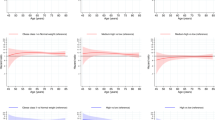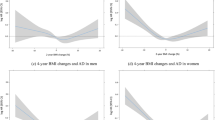Abstract
Background:
In prospective cohort studies, obesity has been linked with a lower risk of subsequent dementia. Reverse causality, whereby neurodegeneration preceding overt dementia symptoms may lower weight, is a possible explanation of these findings. To explore further the weight–dementia association we followed people from early adulthood, an age at which neurodegeneration has typically yet to begin.
Methods:
In all, 33,083 male participants in the Harvard Alumni Health Study underwent a medical examination as undergraduates (typically aged 18 years) during which height, weight, resting pulse rate, blood pressure, physical activity, and smoking status were assessed. Subsamples provided height and weight in 1962/6 (mean age 50.7 years), 1977 (58.6), 1988 (67.5), and 1993 (71.1). Dementia deaths were extracted from death certificates (mean follow-up 53.1 years). We used latent class mixed models to create body mass index (BMI) trajectories; for comparison, we also constructed models with cardiovascular disease (CVD) death.
Results:
We found no association between early life BMI and subsequent dementia (age-adjusted HR 0.94, 95% CI 0.85, 1.04). We identified two latent class groups based on different BMI trajectories—“early decliners” whose BMI began to decline around age 50 years and “late decliners” whose BMI declined about two decades later. The former experienced a raised risk of dementia-related death compared to the latter (multivariable-adjusted HR 1.57, 95% CI 1.14, 2.17). Expected associations were identified between CVD risk factors and CVD death.
Conclusions:
In a population likely to be free of dementia neuropathology at BMI measurement, we found no association between BMI at baseline and subsequent dementia-related death. Earlier decline in BMI was, however, associated with dementia, which suggests that findings associating BMI with dementia risk may be influenced by reverse causality.
This is a preview of subscription content, access via your institution
Access options
Subscribe to this journal
Receive 12 print issues and online access
$259.00 per year
only $21.58 per issue
Buy this article
- Purchase on Springer Link
- Instant access to full article PDF
Prices may be subject to local taxes which are calculated during checkout

Similar content being viewed by others
References
Matthews F, Stephan B, Robinson L, Jagger C, Barnes L, Arthur A, et al. A two decade dementia incidence comparison from the Cognitive Function and Ageing Studies I and II. Nat Commun. 2016;7:11398.
Wu Y-T, Fratiglioni L, Matthews FE, Lobo A, Breteler MMB, Skoog I, et al. Dementia in western Europe: epidemiological evidence and implications for policy making. Lancet Neurol. 2016;15:116–24.
Prince M, Wimo A, Guerchet M, Ali G-C, Wu Y-T, Prina M. World Alzheimer Report 2015. The Global Impact of Dementia: An analysis of prevalence, incidence, cost and trends. London: Alzheimer’s Disease International; 2015.
Ritchie CW, Molinuevo JL, Truyen L, Satlin A, Van der Geyten S, Lovestone S. Development of interventions for the secondary prevention of Alzheimer’s dementia: the European Prevention of Alzheimer’s Dementia (EPAD) project. Lancet Psychiatry. 2015;3:179–86.
Ridge PG, Mukherjee S, Crane PK, Kauwe JS. Alzheimer’s disease: analyzing the missing heritability. PLoS ONE. 2013;8:e79771.
Norton S, Matthews FE, Barnes DE, Yaffe K, Brayne C. Potential for primary prevention of Alzheimer’s disease: an analysis of population-based data. Lancet Neurol. 2014;13:788–94.
Batty GD, Russ TC, Starr JM, Stamatakis E, Kivimaki M. Modifiable cardiovascular disease risk factors as predictors of dementia death: pooling of ten general population-based cohort studies. J Negat Results Biomed. 2014;13:8.
Prince M, Albanese E, Guerchet M, Prina M. World Alzheimer Report 2014. Dementia and risk reduction: An analysis of protective and modifiable factors. London: Alzheimer Disease International; 2014.
Qizilbash N, Gregson J, Johnson ME, Pearce N, Douglas I, Wing K, et al. BMI and risk of dementia in two million people over two decades: a retrospective cohort study. Lancet Diabetes Endocrinol. 2015;3:431–6.
Kivimaki M, Singh-Manoux A, Shipley MJ, Elbaz A. Does midlife obesity really lower dementia risk? Lancet Diabetes Endocrinol. 2015;3:498.
Sperling RA, Aisen PS, Beckett LA, Bennett DA, Craft S, Fagan AM, et al. Toward defining the preclinical stages of Alzheimer’s disease: Recommendations from the National Institute on Aging-Alzheimer’s Association workgroups on diagnostic guidelines for Alzheimer’s disease. Alzheimers Dement. 2011;7:280–92.
Singh-Manoux A, Dugravot A, Shipley M, Brunner EJ, Elbaz A, Sabia S, et al. Obesity trajectories and risk of dementia: 28 years of follow-up in the Whitehall II Study. Alzheimers Dement. 2018;14:178–86.
Kivimäki M, Luukkonen R, Batty GD, Ferrie JE, Pentti J, Nyberg ST et al. Body mass index and risk of dementia: Analysis of individual-level data from 1.3 million individuals. Alzheimers Dement. 2018. https://doi.org/10.1016/j.jalz.2017.09.016.
Paffenbarger RS, Wolf PA, Notkin J, Thorne MC. Chronic disease in former college students: I. Early precursors of fatal coronary heart disease. Am J Epidemiol. 1966;83:314–28.
Shiroma EJ, Sesso HD, Moorthy MV, Buring JE, Lee I-M. Do moderate-intensity and vigorous-intensity physical activities reduce mortality rates to the same extent? J Am Heart Assoc. 2014;3:e000802.
Lee IM, Paffenbarger RS Jr, Hsieh CC. Time trends in physical activity among college alumni, 1962-88. Am J Epidemiol. 1992;135:915–25.
Lee I-M, Sesso HD, Paffenbarger RS. Physical Activity and Coronary Heart Disease Risk in Men: Does the Duration of Exercise Episodes Predict Risk? Circulation. 2000;102:981–6.
World Health Organization. International Classification of Diseases, 1955 Revision. Geneva: World Health Organization; 1957.
Cox DR. Regression models and life tables (with discussion). J R Stat Soc Ser B. 1972;34:187–220.
Proust-Lima C, Philipps V, Liquet B. Estimation of extended mixed models using latent classes and latent processes: the R package lcmm. J Stat Soft. 2017;78:1–56.
Russ TC, Batty GD, Starr JM. Cognitive and behavioural predictors of survival in Alzheimer disease: results from a sample of treated patients in a tertiary-referral memory clinic. Int J Geriatr Psychiatry. 2012;27:844–53.
Russ TC, Gatz M, Pedersen NL, Hannah J, Wyper G, Batty GD, et al. Geographical variation in dementia: examining the role of environmental factors in Sweden and Scotland. Epidemiol (Camb, Mass). 2015;26:263–70.
Lee I-M, Paffenbarger RS Jr. Physical activity and stroke incidence: the Harvard Alumni Health Study. Stroke. 1998;29:2049–54.
Batty GD, Shipley M, Tabak A, Singh-Manoux A, Brunner E, Britton A, et al. Generalizability of occupational cohort study findings. Epidemiol (Camb, Mass). 2014;25:932–3.
Acknowledgements
This is Report Number XCVIII in a series on chronic diseases in former college students. All researchers are independent of funders who played no role in this study. TCR and GDB are members of both the Alzheimer Scotland Dementia Research Centre funded by Alzheimer Scotland and the University of Edinburgh Centre for Cognitive Ageing & Cognitive Epidemiology, part of the cross council Lifelong Health and Wellbeing Initiative (G0700704/ 84698). Funding from the Biotechnology and Biological Sciences Research Council, Engineering and Physical Sciences Research Council, Economic and Social Research Council, and Medical Research Council is gratefully acknowledged for the latter. TCR was supported by Alzheimer Scotland through the Marjorie MacBeath fellowship from 2016-17 and was funded as a clinical research fellow by them from 2009 to 2013. He was employed by the University of Edinburgh from 2014 to 2017 and is now employed by the UK National Health Service. GDB is supported by the UK Medical Research Council (MR/P023444/1) and the US National Institute on Aging (1R56AG052519-01; 1R01AG052519-01A1).
Funding
This work was supported by Alzheimer Scotland.
Author contributions
GDB generated the idea for the study; GDB and TCR prepared the manuscript; IML and HDS were responsible for the follow-up of the study participants; TCR conducted the analyses with guidance in latent class modelling from GMT; and all authors revised the manuscript for intellectual content.
Author information
Authors and Affiliations
Corresponding author
Ethics declarations
Conflict of interest
The authors declare that they have no conflict of interest.
Electronic supplementary material
Rights and permissions
About this article
Cite this article
Russ, T.C., Lee, IM., Sesso, H.D. et al. Five-decade trajectories in body mass index in relation to dementia death: follow-up of 33,083 male Harvard University alumni. Int J Obes 43, 1822–1829 (2019). https://doi.org/10.1038/s41366-018-0274-z
Received:
Revised:
Accepted:
Published:
Issue Date:
DOI: https://doi.org/10.1038/s41366-018-0274-z
This article is cited by
-
Design and overview of the Origins of Alzheimer’s Disease Across the Life course (ORACLE) study
European Journal of Epidemiology (2021)
-
Age-dependent effects of body mass index across the adult life span on the risk of dementia: a cohort study with a genetic approach
BMC Medicine (2020)



